I value and cherish the historical context of Commander and our format’s storied history. Unfortunately, I worry that context has not been archived and will eventually be lost to time. So in a fit of hubris, I decided to sit down and analyze the legendary creatures that have come out of each Commander product in a constructive, long-term sense.
Today I start with very first preconstructed Commander decks, released in June 2011, which came to be known as Commander 2011. We’re going back to a time ruled by Child of Alara, Jhoira of the Ghitu, Mayael the Anima, and Zur the Enchanter. We had mana fixing like Hallowed Fountain and Rugged Prairie, but for budget players, we had the Magic 2010 check lands, but not Innistrad’s cycle to fill out all ten color pairs.
At the time, what we would know as wedges only had six different commanders to choose from and almost no spells to speak of, especially that were of the caliber for Commander. Enter the first Commander product, with its five decks sporting fifteen new legendary creatures total—two for each wedge and a cycle of enemy color paired creatures. I can say that the product was highly coveted and the excitement extended from the Winter 2010 announcement, all the way up to the set’s release, which saw multiple printings to meet demand.
Today, we will be evaluating each of the legendary creatures that premiered in Magic the Gathering: Commander aka Commander 2011 based on their reception at the time, how they created or supported an archetype, and answer if they maintained any sustained usage. To maintain some structure, we’ll group each trio into the decks they premiered in.
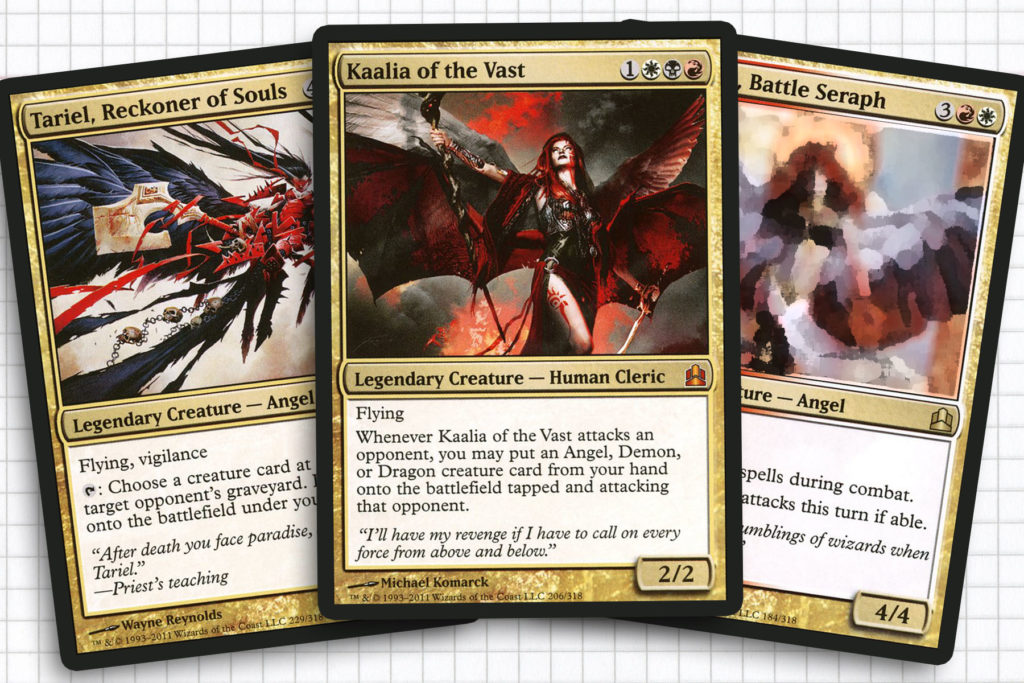
Heavenly Inferno
Let’s start with the immensely iconic Kaalia of the Vast. For the time, this was the kind of legendary creature they needed to help sell the set. With Oros, the Avenger being the only pre-existing option for Mardu, Kaalia was an objectively more aggressive general that highlighted the iconic creatures from each of the three colors. And to be honest I don’t know if we’ve seen another legendary creature that could pilot multiple different tribes so successfully and resonate with the audience. She is still in the Top 50 legendary creatures on EDHrec, so it’s safe to say she’s retained some staying power.
Unfortunately, the rest of Heavenly Inferno isn’t remembered as fondly. Tariel, Reckoner of Souls always read to me like a creature we could have seen in Standard, that was designed to see play in Commander. And for the time, that was a half decent power level for the card. Tariel is very overcosted for little to no consistency. The idea of reanimating your opponents’ creatures is a good starting point, but if Tariel swapped vigilance for haste, they would have been remembered better. The decks I can remember that tried to build around them used a lot of targeted graveyard hate to remove the randomness for their ability. But ultimately, they flamed out.
Basandra, Battle Seraph is possibly the most forgettable legendary creature to come out of the entire product. I can understand Wizards’ thought process, particularly early on, to design something for Boros that didn’t strictly win through combat but also didn’t violate the color pie too badly. Sadly, what resulted was legend for a color combination that thrives on combat tricks stopping combat tricks from happening. I actually think that with the right support, something that radically changed how Boros played could have started here; but honestly, Wizards was right to test the waters elsewhere with creatures like Feather, the Redeemed and Winota, Joiner of Forces.
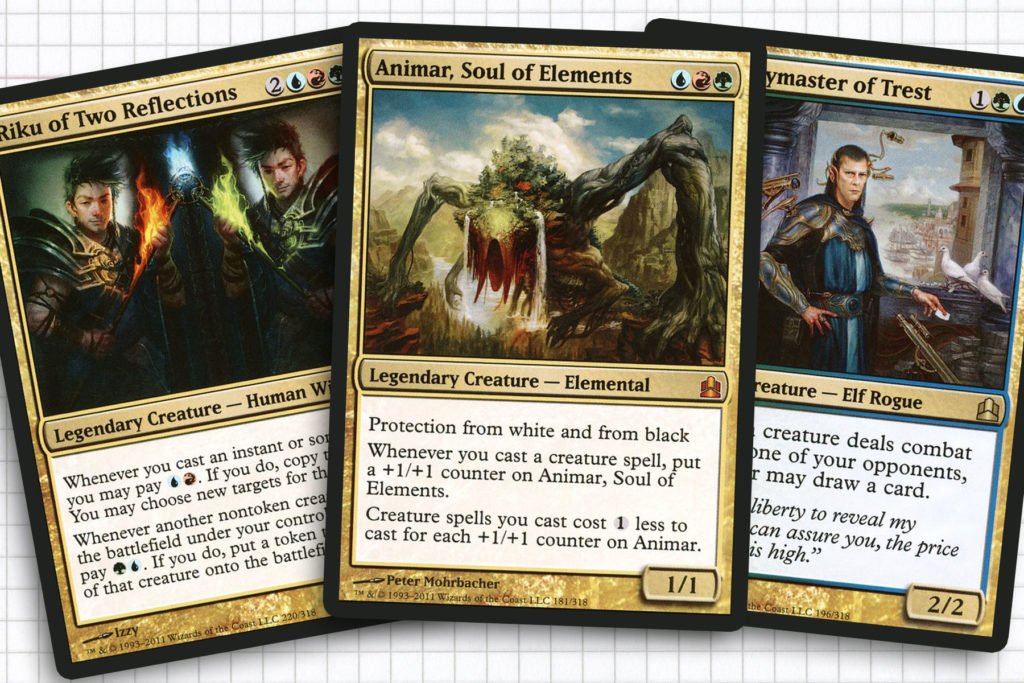
Mirror Mastery
Riku of Two Reflections was one of those generals I remember a lot of players clamoring for when the set was being previewed. I’ll admit never tickled my fancy, due to a lack of imagination on my own part. Unlike a lot of other generals to come out of the product, Riku sat at just the right mana cost to do nothing the first turn they were out. In a metagame where Sharuum the Hegemon was possibly coming down the same turn and kicking off a convoluted combo, Riku was too little too late. Despite that, there’s no other general quite like Riku and he never went away. Replicating Volcanic Vision or Turnabout can catch unsuspecting opponents off guard, just before you duplicate Avenger of Zendikar with Brudiclad, Telchor Engineer in play.
Animar, Soul of Elements has always been a powerful general that stood the test of time very well. What has made Animar such a staple of the format is just how open ended the design is. Animar has always been a highly versatile general that has helped to create a lot of different archetypical decks, ranging from hydra to morph tribal, before a better general could be discovered or even created from whole cloth by Wizards.
Edric, Spymaster of Trest has a solid legacy in the format, making Mirror Mastery a solid deck overall. The one difference is that Edric has always been the perennial other 99 card. While I appreciate the fact that he creates interaction between players, it was never any question that his best place was within a deck that fit his color combination.
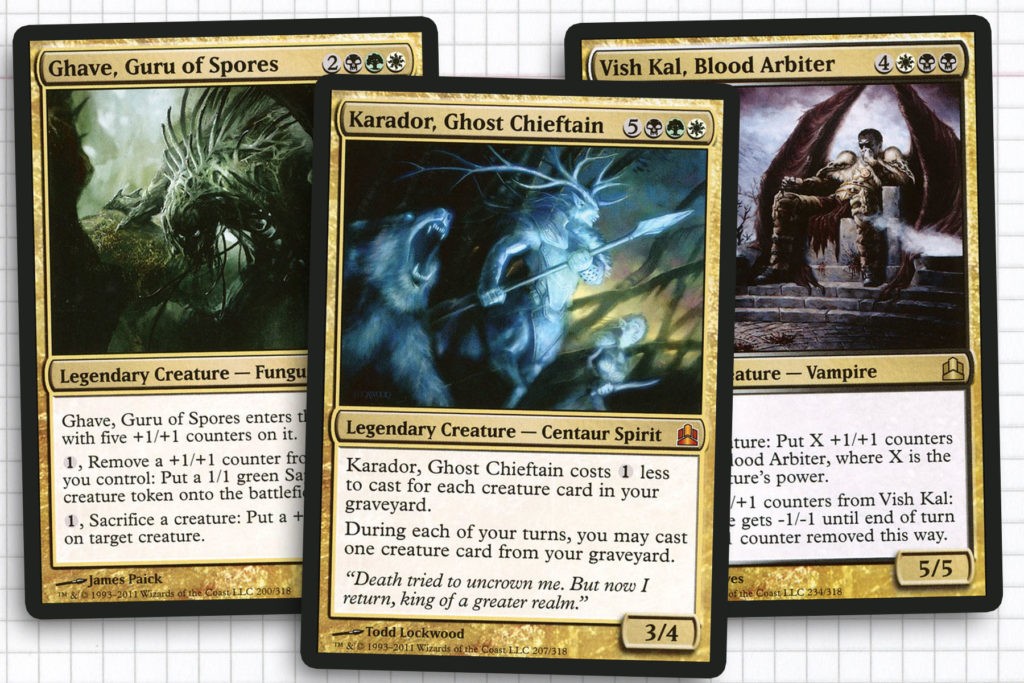
Counterpunch
Ghave, Guru of Spores burst into the format at full speed, a solid example of Wizards’ willingness to design generals that were value engines from the very beginning. If memory serves, he was viewed as very powerful almost immediately. As we will find with many of the generals coming out of this product, Ghave is costs more than we might expect nowadays. Ghave fed a well-supported tokens archetype for the time, and allowed it to develop into Abzan.
Karador, Ghost Chieftain was one of the first legendary creatures we saw from the product. I think Wizards got a lot right here, building Karador for the long game with their ability to reduce their cost and by extension, commander tax and restricting the reanimation ability to once per turn. This pushed players piloting the deck to focus more on reanimating something powerful over a swarm of smaller creatures to build exclusively towards a combo.
I am conflicted when it comes to Vish Kal, Blood Arbiter, because I can remember when Vish Kal first came out I wanted to make it into something. What would eventually become my Doran, the Siege Tower deck started here, because I thought this would be where a Voltron lifegain deck would come from. Unfortunately while I understand the intention, Vish Kal is too expensive to make an impact.
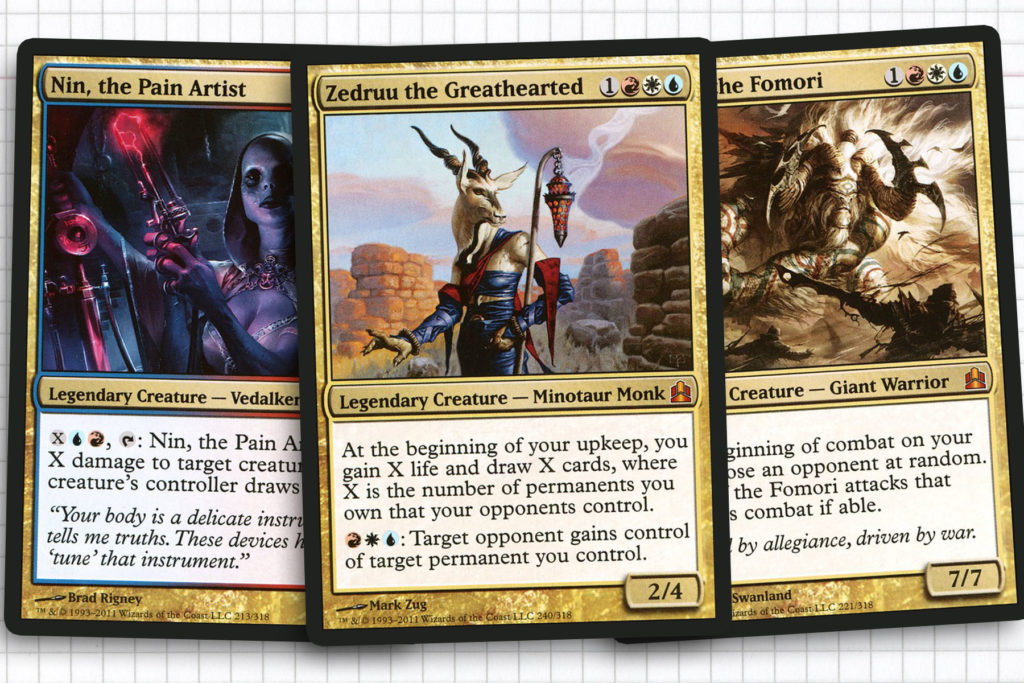
Political Puppets
The deck titled Political Puppets has always proven to be one of my blind spots. I like the three generals that came out of the deck, but never felt inspired to build around the marquee Zedruu the Greathearted. While group hug had always been a popular strategy dating back to the origins of the format, Zedruu created a group hug deck that did less fortifying to accomplish its goals; instead choosing to appear defenseless while accruing valuable life and card draw. And Zedruu has never gone away, maintaining its place as a Jeskai deck that’s less flashy and doesn’t depend on casting a lot of spells every turn.
Simply put, Ruhan of the Fomori is a diamond in the rough and maybe my favorite Voltron commander. Ruhan came in with a lot of criticism for having no way to play politics. And while it’s hard to disagree with that notion on the surface, the politics lie in the fact that you can feign a lack of no control to your advantage and never be perceived as a threat until it’s too late. All that said, Ruhan remains in relative obscurity, highlighted infrequently by an episode of Game Knights and myself.
Lastly, we have Nin, the Pain Artist, who by my understanding was designed to give the pinger archetype its go-to general. I think that was a failed experiment; but if this review taught me anything, it’s that Wizards created a shockingly low amount of failed experiments in this product. Nin sits at the right mana cost and is open-ended enough that you can be perceived as a pinger deck when in reality you could conceivably be working to mill somebody out. She has found her way into decks led by Nekusar, the Mindrazer and The Locust God, which seems like a fine place for her.
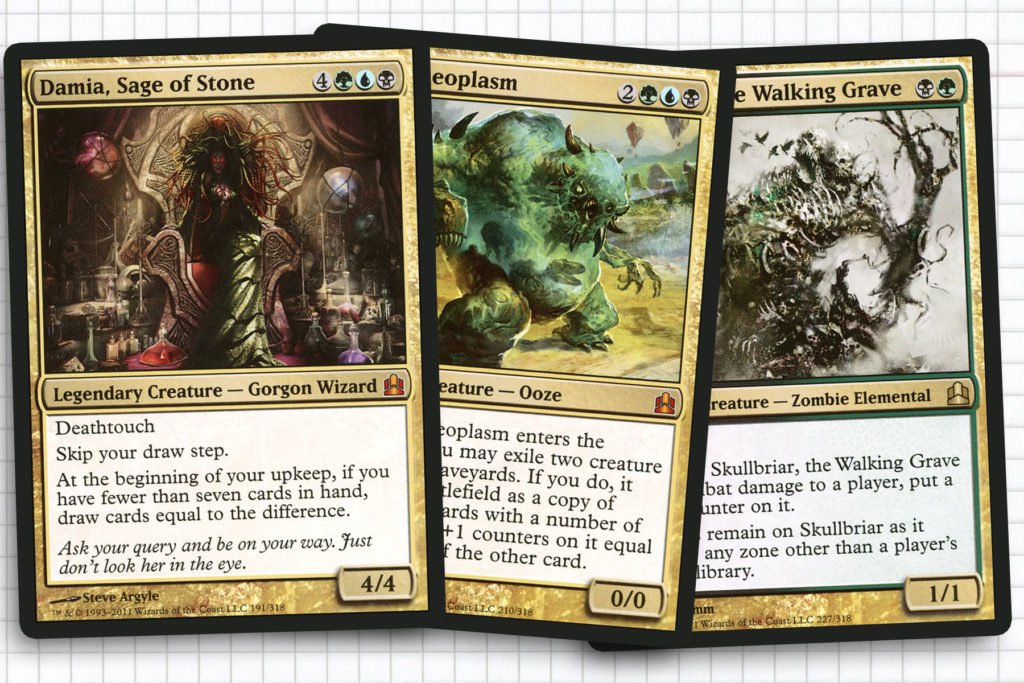
Devour for Power
Finally we have what in hindsight is one of the more stacked decks of the product. All three of the new legendary creatures coming out of this deck have made some impression in the format, especially on me. The Mimeoplasm fills a role that was in high demand at the time. We had seen decks that could manipulate the graveyard in the past and we had mono blue decks that could fill the clone archetype. Through The Mimeoplasm we got both at once. I’ve written about The Mimeoplasm before; it’s a fantastic deck with a fantastic general that is open-ended enough to not have a “correct build.” I think that as the years go by it may not be the first deck that everyone thinks about, but it gets a new toy for consideration nearly every set.
Compare that to one of the least improved generals, Damia, Sage of Stone. Damia was one of the most synonymous generals for the first two years after the product came out. While not creating any new archetypes, the deck allowed for some pretty incredible combos. But over time, Damia has disappeared and it’s no surprise: following Khans of Tarkir six years ago, Sultai generals have completely outclassed her, even just as a general you use for the colors.
Skullbriar, the Walking Grave has had a weird history with the format. At the time of its printing, the biggest obstacle it faced was the tuck rule which allowed generals to be put into their owner’s deck, negating Skullbriar’s ability. But after tuck was removed, Skullbriar was identified as having a very bright future. Unfortunately, I think the color combination just wasn’t right for the audience that really would have loved to play it. I happen to like the card for its aggressive Voltron slant; but I don’t know if it will ever gain much prominence, as Kathril, Aspect Warper has a very similar gimmick with an additional color.
A big takeaway having gone over each one of these legendary creatures is that they read as a little dated, for obvious reasons; but I appreciate that a high ratio of them are not value machines built to be as efficient as possible. Riku of Two Reflections and Vish Kal, Blood Arbiter are probably overcosted. But there’s also value in having some of these cards work better within the 99 instead of leading a deck.
The ideas coming out of this set and the impact that some of the best generals made leaves me with this: Commander 2011 was a solid product and immensely successful for the first venture into this area of product design. There’s a reason why it’s become an annual product and in a future installment, we will talk about Wizards’ second attempt at designing directly for Commander.
Ryan Sainio is a Graphic Designer who writes about EDH and the EDH community. He has been playing Magic: The Gathering since 7th Edition in 2002 and values flavorful and fun gameplay over competitively optimized decks.

